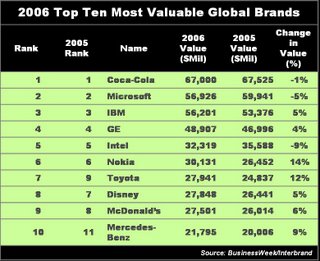Marketers Are The Investment Bankers Of Brands
Is Your Brand Gaining Or Decreasing In Value?

You have no doubt heard the term, R.O.M.I (Return On Marketing Investment). It is the critical metric on the success of a brand's marketing investment. Just like an investment banker's success is measured on the increased value of investment portfolios, a marketer is responsible for increasing brand value for the company. The CMO of a company is really a CMIO (Chief Marketing Investment Officer).
For the past six years, for example, BusinessWeek and global brand consultancy, Interbrand have produced its annual rankings on the most valuable brands in the world. The report identifies the top 100 global brands that have managed to create and sustain strong performance in today’s competitive market. (The Top Ten Global Brands are shown in the chart above) Brand values were determined using the method Interbrand pioneered nearly 20 years ago and has since used to value more than 4,000 brands. Brand value is calculated as the net present value of the earnings the brand is expected to generate and secure in the future for the time frame from July 1, 2005 to June 30, 2006.
BusinessWeek 2006 Best Global Brands Highlights
Turnaround Performances: After year over year decline from 2000 to 2004, Nokia (#6) has regained its leadership position in the mobile telecom industry with growth in both the high and low ends of the market. Nokia’s scale has always made it competitive in the rapidly growing low priced segment, but a resurgence in design and a concentration on desirable features has meant that Nokia is now able to maintain its average selling price and reinvigorate its brand image with the high end consumer. Likewise, Motorola (#69) has historically struggled in the high end of the market…until the Razr. A hero product, it has in recent years helped the brand maintain its solid number two position in the category.
Top Gainers: The top gainer with a brand value increase of 46%, Google (#24) creates growth under with the strategy of "do no evil" positioning itself at the opposite end of the spectrum from the more corporate Microsoft. Overall growth of Internet commerce has perpetuated consumers’ acceptance of purchasing goods and services online enabling eBay (#47) to skyrocket in value up 18% and the third highest gainer this year. In the second spot with a value increase of 20%, Starbucks (#91) has found financial success by leveraging the brand with a premium fast food and extending its product offering into music and publishing.
Top Decliners: The growth of mass retailers has taken market share from traditional apparel brands such as Gap (#52). Losing the most brand value with a decline of -22%, Gap has been unable to clarify its brand image and with a less distinct positioning the brand has been less effective at selling clothing causing reduced long-term stability. Ford (#30) continues to lose money on every car sold – and brand value year after year. Down -16% this year, Ford’s American heritage is an insufficient brand attribute to hold off growing competition from Japanese and German automakers. Down -12% this year, Kodak (#70) has made valiant strides to catch up with the digital world, however the reality is that competition is fierce and profitability is thin compared to Kodak’s film business and thus the brand’s value continues to decline.
In summary, it is important to understand that every marketing decision for a brand is an investment decision. Invest wisely.

